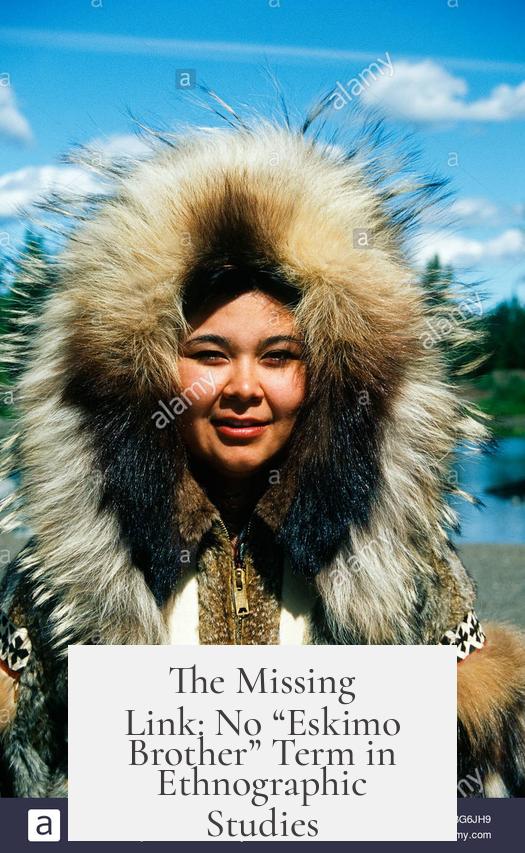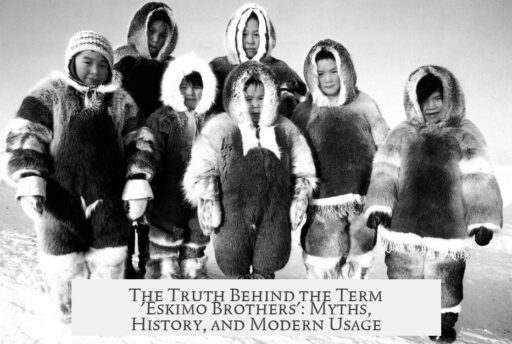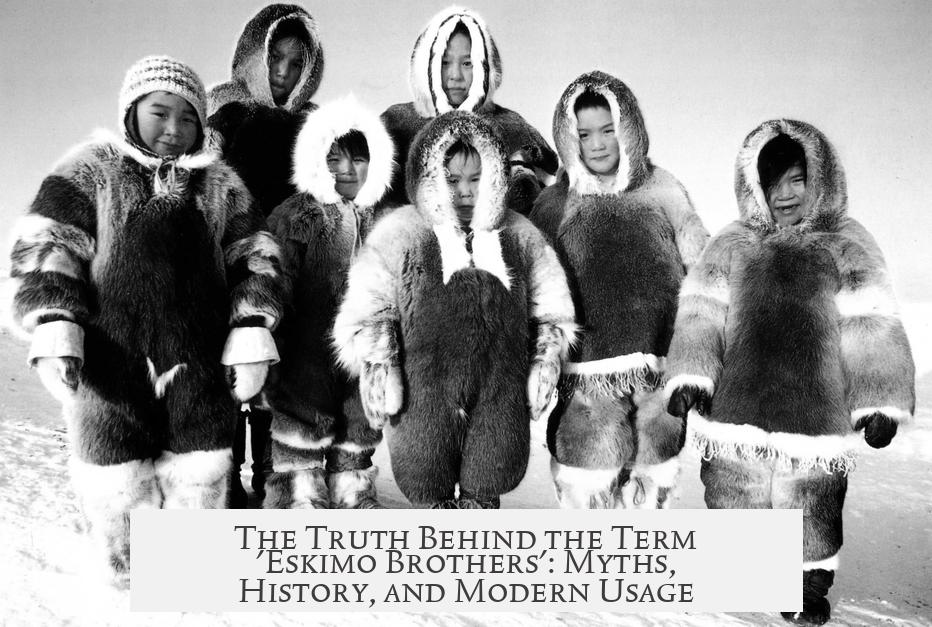The term “Eskimo brothers” lacks a clear historical origin in its contemporary usage relating to men who have shared the same sexual partner. Historical references to “Eskimo brothers” primarily concern actual siblings among Eskimo communities or metaphorical brotherhoods, such as spiritual or social bonds, rather than any sexual connotation. Searches in historical texts show the phrase predominantly applied to family or communal relationships, not the modern slang.
The contemporary slang meaning appears disconnected from authentic cultural or ethnographic origins. No strong evidence places the term “Eskimo brothers” in traditional records or anthropological studies with that meaning, indicating it is a more recent linguistic invention or metaphor.
However, some ethnographic context helps clarify possible influences. Among certain Eskimo groups, practices involving wife sharing or spousal exchanges occurred under complex social and religious systems.
- Wife swapping occurred in specific, ritualistic, or communal contexts, often linked to religious specialists or shamans aiming for community benefits, like improved hunting prospects.
- Such exchanges varied by region and were not universally practiced or expected.
- Long-term husband exchanges sometimes lasted a week or more, serving to strengthen ties between families or communities.
While these practices involved sharing sexual partners, they differ from the casual or humorous tone attributed to “Eskimo brothers” in modern slang.
Crucially, ethnographic records reveal:
“No Eskimo male was ever expected to offer his wife to a visitor, and it never happened as a matter of course. Most men traveled with their wives, and although some volunteered to lend their wives, there was a general aversion to doing so.”
Thus, any sexual partner sharing was conditional, voluntary, and embedded in reciprocal social protocols. Reciprocity sometimes implied that if a man slept with another’s wife, the reverse occurred later, maintaining social balance and alliances. This differs significantly from the casual connotation of “Eskimo brothers” as men sharing a sexual partner without such cultural framing.
Importantly, none of the traditional accounts use the term “Eskimo brothers” or anything similar. The phrase itself is absent in scientific and ethnographic literature describing these cultural practices.
Regarding the term “Eskimo,” some clarification is necessary. “Eskimo” broadly refers to indigenous Arctic peoples and is not synonymous with “Inuit,” though often confused or used interchangeably.
- Inuit specifically refers to speakers of the Inupik language group, predominantly found in Canada and Greenland.
- Eskimo is a broader category that includes Inuit and Yupik groups.
- Yupik people, largely in western and southern Alaska and eastern Siberia, speak languages distinct from Inuit and prefer the term Yuit or Yuk for themselves.
- Greenland Inuit often identify as Kalaallit, their native term for their land and people.
- The term Eskimo persists in Alaska due to this complex linguistic and ethnic makeup, despite controversy about its usage elsewhere.
This linguistic clarification highlights that the modern slang term “Eskimo brothers” does not arise from a monolithic or uniform indigenous culture but from a general and imprecise usage of “Eskimo.”
The origin of “Eskimo brothers” as a slang term likely stems from modern, possibly urban or college vernacular detached from any authentic indigenous cultural meanings. It invokes exoticism rather than reflecting documented cultural practices. The actual husband-wife exchange customs among Eskimos appear structured, ritualistic, and far more nuanced than the slang term implies.
| Aspect | Details |
|---|---|
| Historical Use of “Eskimo brothers” | Refers to actual brothers or figurative brotherhood, no sexual meaning |
| Wife Sharing Among Eskimos | Occasional, ritualized, reciprocal, and regionally varied practices |
| Ethnographic Mention of “Eskimo brothers” | Absent in academic sources describing wife sharing practices |
| Term “Eskimo” Usage | Broad term including Inuit and Yupik, varies by region |
| Origin of Slang Term | No verified indigenous source; modern slang with questionable cultural roots |
- “Eskimo brothers” as used today does not have a verified historical or ethnographic origin.
- Wife sharing did occur in some Eskimo cultures but under specific, ritual, and reciprocal conditions.
- The phrase “Eskimo brothers” is not documented in these cultural practices.
- Term “Eskimo” broadly covers distinct native groups with different languages and customs.
- The slang likely emerged independently from indigenous traditions.
On the Origin of the Term “Eskimo Brothers”: Unpacking the Myth and the Facts

If you asked about the origin of the term Eskimo brothers, here’s the straight talk: the phrase, as commonly understood today, has no clear historical origin or ethnographic basis linking it directly to Eskimo culture. Instead, its contemporary usage emerges largely from slang and modern colloquialism, divorced from actual Eskimo (or Inuit and Yupik) social customs. So what’s going on behind this curious term? Let’s dig into the story.
The Slippery History of Eskimo Brothers
Trying to trace the term “Eskimo brothers” through history? Good luck. Digital archives, including Google Books Ngram Viewer, show that older uses pertain mainly to literal or figurative siblings among Eskimos. This means either direct family ties or, more loosely, tribal brotherhood or kinship-like bonds (think “brothers in Christ”).
But the slang meaning of “Eskimo brothers”—referring to two men who have had sexual relations with the same woman—is not historically documented in Eskimo communities. It seems to be one of those phrases that slipped unmoored from native traditions and took on a life of its own in modern popular culture, especially in Western circles.
What About the Myth of Wife Sharing?
Popular gossip suggests that Eskimo men “lend” their wives to visitors, implying a communal or hospitable sexual culture that supposedly birthed this term. That’s a juicy story, but the reality is more complex. According to research shared by The Straight Dope, wife-sharing among Inuit and Yupik peoples did happen – but:
- It was rare, highly situational, and rarely “casual.” Usually linked to specific religious or social goals, often driven by shamans or specialists.
- It sometimes involved longer-term husband exchanges, not just one-off encounters.
- Such practices aimed to strengthen social ties, create alliances, or fulfill ritual purposes, rather than “hospitality” as serving tea and biscuits.
- Wife-sharing was often resisted by the women involved and was usually consensual rather than expected or mandated.
- Reciprocity was implicit: if one husband lent his wife, he might later have access to the other man’s wife.
None of these nuances matches the slang term’s typical usage or suggest a brother-like bond derived from it.
The Missing Link: No “Eskimo Brother” Term in Ethnographic Studies

Despite the presence of wife-sharing in limited contexts, there’s no mention of the term “Eskimo brothers” or anything similar in detailed ethnographic work. These cultural practices were not called that, nor did they function socially as a fraternity-style “boys club” term. From this, we see that “Eskimo brothers” is a modern linguistic invention, not an indigenous phrase.
Understanding the Term “Eskimo”
Now, a small cultural geography lesson is essential to avoid confusion and unintended offense when talking about these groups. “Eskimo” is a broad term covering various indigenous peoples of the Arctic. In Canada, the preferred term is often “Inuit,” which refers specifically to speakers of certain dialects like Inupik. In Alaska, “Eskimo” remains more widely accepted because it covers both Inuit and Yupik groups, which speak related but distinct languages.
The Eskimo peoples stretch from western Alaska across the Arctic to Greenland and Siberia, each with different languages and cultures. Their social customs are diverse, so applying a single term—especially a slang one—oversimplifies and distorts their lives. The gloss “Eskimo brothers,” despite its catchiness, fails to acknowledge this cultural complexity.
So Why Does Everyone Use It Then?
This is where modern slang and cultural appropriation mash together. The term likely emerged in English-speaking circles uninformed about Arctic cultures. It evokes an exotic twist on a universal human situation: two guys who share a sexual partner.
It’s crucial to recognize that using “Eskimo brothers” without context risks misunderstanding and unintentional cultural offense. It’s a nickname built on shaky historical and ethnographic ground.
Practical Takeaways: Navigating This Term Today

- Respect cultural complexity. When talking about indigenous peoples, prefer precise terms like Inuit or Yupik over blanket phrases.
- Use slang cautiously. Recognize that “Eskimo brothers” is a modern vernacular phrase with no real connection to Arctic cultures.
- Question what you hear. If a term sounds exotic or colorful, dig deeper before repeating it.
- Keep humor kind. Slang can be fun but avoid perpetuating stereotypes or misinformation.
Final Thoughts
The phrase “Eskimo brothers” is a great example of how language evolves in surprising ways, sometimes without regard for accuracy or respect. While it has a catchy ring and humorous appeal, its roots are shallow, mixed with myths about Arctic cultures and oversimplified gossip about wife-sharing customs.
Its actual origin remains murky, and the practice it supposedly describes, while somewhat documented, is far from typical or casually referenced in native communities. The term’s persistence reminds us: words matter, especially when they claim cultural connections. Before you call someone your Eskimo brother, maybe pause and consider what that phrase really means—and what it might miss.




